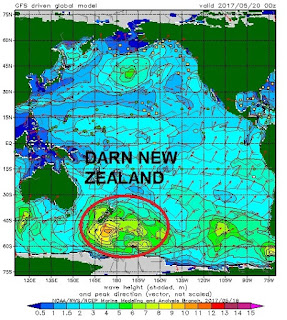Gettin' up early to dawn patrol Goat Hill!
SURF:
Quick but concise THE Surf Report tonight friends. Playing golf tomorrow to benefit Urban Surf 4 Kids at the 3rd Annual North County Board Meeting Golf Tournament. A good way to kick off a long weekend.
FORECAST:
Better late than never for Memorial Day; high pressure sets up shop and we have sunny skies and beach temps in the mid-70's.
WEATHER:
As advertised above, we have some cool/cloudy conditions today and tomorrow. High pressure starts to build slowly on Saturday and by the last day of the Memorial Day weekend (Monday for those of you keeping score), we've got nice conditions with sunny skies and temps in the mid-70's. That's short lived though as another weak front moves through late Tuesday and the 2nd half of next week looks cool with partial afternoon clearing. Pretty typical for May. Nothing to get excited about- guess we have to wait for those late summer thunderstorms to get any action around here.
BEST BET:
Monday. Happy Memorial Day everyone.
NEWS OF THE WEEK:
The National Oceanic and Atmospheric Administration (NOAA) issued their annual hurricane forecast this week for the Atlantic, Eastern Pacific (i.e. our storms off Baja), and the Central Pacific (i.e. Hawaii). So after the past few years of great surf around here, what's their prognosis?...
An 80 percent chance of a near- or above-normal season is predicted for each region. The eastern Pacific outlook also calls for a 70 percent probability of 14 to 20 named storms, of which 6 to 11 are expected to become hurricanes, including 3 to 7 major hurricanes. The central Pacific outlook calls for a 70 percent probability of 5 to 8 tropical cyclones, which includes tropical depressions, tropical storms and hurricanes.
Long story short, we're transitioning from a weak La Nina (bad) to a weak El Nino (not great but better than La Nina). So our water temps should be slightly above normal (probably peaking in the mid-70's this summer) and a couple extra hurricanes thrown in for good measure. Awesome. On the flip side, a few oceanographers have said recently that our warmer than normal water temps the past few years have been one of the reasons for the increased sightings of juvenile great whites (juvenile is a relative term since most of them have been around 10' in length). So with the water being trunkable this summer and a couple bonus hurricanes, we have to deal with an extra shark or too around here. Pick your poison.
BEST OF THE BLOG:
Been thinking about giving back to your community? Here's your chance: Join the North County Board Meeting! Help grow local businesses, support charities, network, and above all... surf! Want to know more? Check out ncboardmeeting.org today. And for your information, the NCBM had a hat trick this week. In particular:
1. Our 3rd Annual Golf tournament is tomorrow at Goat Hill Park in Oceanside, benefiting Urban Surf 4 Kids. Urban Surf 4 Kids is a unique outreach organization that works with orphan and foster kids. Using water sports as a catalyst, they teach kids how to first have fun and then give back to their communities and neighborhoods through local service projects. The NCBM is honored to help support their cause. Want to also give a big thanks to the following:
-Presenting sponsor Hanscom, Alexeev & McDaniel LLP.
-John Ashworth for hosting a 3rd year in a row at his ultra-fun Goat Hill Park.
-Hole sponsors: Berg Insurance Agency, Silvergate Bank, TPC/HR Payroll, Henebery Whiskey, EPK Collection, Knutson Reeves Insurance Services, Taylor Kudell- Carrington Real Estate Services, LJA Coaching, Dana Albert at Merrill Lynch Wealth Management, Leavitt Group of San Diego, Wounded Warrior Homes, Agency 73, OrganikSEO.com, Visit Carlsbad, MINUS EGO, and Filtrate Eyewear
-Raffle and Swag Bag sponsors: SUPERbrand, Tracker Trucks, Nixon, Green Plate Meals, Lululemon, Leus Towels, EPK Collection, Priority Public House, Pizzicato, Filtrate Eyewear, Beacons Point, Retirement Benefits Group, and Carlsbad Lifestyle Magazine
2. Speaking of Carlsbad Lifestyle Magazine, guess who made the cover? Easy answer- North County Board Meeting of course. Thank you to Lucy Jones and her staff for spreading the word. Some band named Switchfoot also made the mag but I don't listen to the radio much. Anyway, make sure to pick up the latest issue around town or read it online here. Just remember the camera adds 10 pounds and 10 years.
3. North County Board Meeting turned 3! And we're not toddlers might I add. The group has donated tens of thousands to local charities, grown to over 125 members, supported local businesses, and surfed some of the best waves in history (thanks to Hurricane Marie, our Surf Meeting in August 2014 was legendary). Who says giving back can't be fun at the same time? Not the North County Board Meeting. Email me at northcountysurf@cox.net to find out how you can make your community a better place.
PIC OF THE WEEK:
Rumor has it The Who wrote 'I Can See For Miles' when they surfed this point back in 1967. Ironically, they've kept it for secret for 50 years even though the song was on the album called 'The Who Sell Out'. True story. Sort of.
Keep Surfing,
Michael W. Glenn
Real-life Superman
Just Got Signed By Big Baller
If Kelly Can Surf AM, Golf PM, Why Can't I?

































